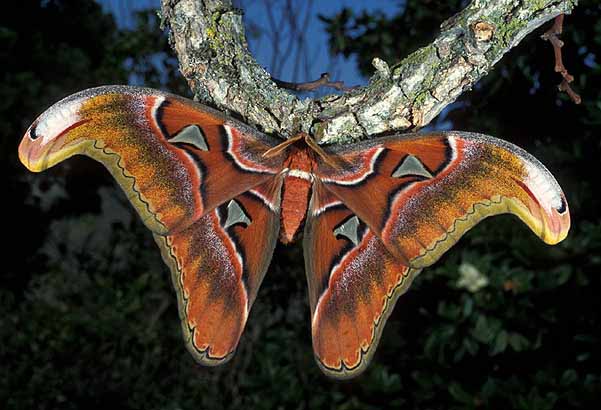
Attacus lorquini (Attacus lorquini)
Phylum — arthropoda
Class — insecta
Order — lepidoptera
Family — saturniidae
Genus – attacus
Appearance
Newborn caterpillars are black and white with numerous outgrowths. Later, they turn green. The caterpillar is covered with hairs.
The wingspan of these butterflies is up to 20 cm. The body of the butterfly is covered with hairs. Males have feathery antennae. The main background color is brown with ochreous, there are white spots on the wings.
Habitat
Attacus lorquini lives in the Philippines.
Behavior
These butterflies are nocturnal.
Diet
The caterpillars feed on the leaves of lilac and privet.
Reproduction
For their reproduction you need a mesh terrarium with a size of 70 x 70 x 90 cm. Each female lays about 100 eggs. She sticks them to the food plant. The eggs are white, 2-3 mm long. The duration of incubation is 8-10 days. Incubation at a humidity of 70-80% and a temperature of 22-24°C. It is better to keep the caterpillars in mesh terrariums for 6-8 insects. It is necessary to place a branch of a forage plant in it. Forage plants should be replaced every 3-4 days. There should be no water droplets on the leaves, otherwise the caterpillars may die. It is necessary to ensure that the forage plants are fresh and in no case do not allow crowding of the caterpillars. They should be kept at the temperature of 22-24 °C and humidity of 60-70%. The caterpillar develops for 3-5 weeks. The caterpillar then makes a cocoon by weaving in the leaves of the food plant in which it pupates. The cocoon is light brown. The butterfly leaves the cocoon after 3 weeks. You can enter the pupae into diapause by placing them in the refrigerator for a week, then they will hatch in 5-6 months. Before hatching, the temperature should be increased to 25-27°C, and the humidity should be increased to 70-80%. The butterfly's life span is 5-7 days.
In captivity
The mesh terrarium with a size of 70 × 70 × 90 mm is suitable for keeping butterflies. Room temperature is necessary. Adult butterflies of this species do not feed and live off the stocks accumulated during the larval period.
 Russian
Russian
 English
English























